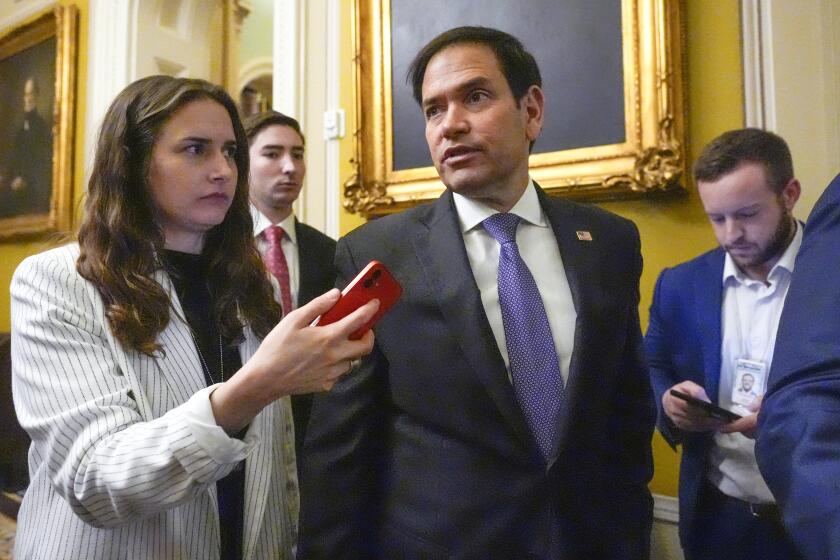Europe banks gobble up cheap loans offered by Central Bank
Faced with the threat of another regional recession, the European Central Bank said Wednesday that it was doling out more than half a trillion dollars in special long-term loans to hundreds of financial institutions in a bid to keep credit flowing.
Demand for the cheap three-year loans set a lending record for the ECB, underscoring how fragile Europe’s financial system remains as banks struggle to raise funds on the open market because of the euro debt crisis. The $640-billion infusion to 523 banks outstrips the $576 billion that the ECB issued in special one-year loans in June 2009 after the global financial meltdown.
The new loan program comes as European officials clash over their latest effort to shore up the troubled euro, the agreement by most European Union nations this month to sign a treaty imposing strict caps on public borrowing and spending. Negotiations over the pact’s details have run into snags, leading some analysts to doubt whether it will be ready in time for its scheduled ratification in March.
The treaty aims for long-term stability for the euro but has little bearing on the immediate debt crisis facing the currency. To help tackle that, the ECB rolled out its special three-year loans to ease a growing credit crunch and increase liquidity in the Eurozone, the 17 nations that use the euro.
The money, lent at the low interest rate of 1%, proved attractive to many financial institutions that are highly exposed to government debt and that have therefore found it hard to borrow commercially.
“It provides some stability to the funding of banks which have more or less completely lost market access,” said Sony Kapoor of the think tank Re-Define.
But the record response to the ECB’s offer is a sign of how dire the situation has become, Kapoor said. He warned that the new loans failed to address the heart of the euro crisis: the loss of faith in Europe’s banks and in the heavily indebted governments that stand behind them, especially in peripheral countries of the Eurozone.
“Until full faith is restored in the solvency of Italy and Spain, we are not going to see a restoration of confidence in the European banking system,” Kapoor said. “This is applying a Band-Aid to a wound that is very deep and requires more radical surgery.”
The scramble by European banks for liquidity triggered concern among traders, pushing stock markets lower Wednesday. Both Germany’s DAX and France’s CAC-40 index dropped nearly 1% during trading, while the broader Stoxx Europe 600 fell 0.5%. The drops had little effect on U.S. stocks, with both the Standard & Poor’s 500 index and Dow Jones industrial average finishing higher on the day.
Meanwhile, European government bond yields rose on fear that banks might back away from buying more sovereign debt amid pressure to reduce risk on their balance sheets.
Still, Europe appears to be enjoying at least a temporary respite from the storm that battered the region’s economy just a month ago, when borrowing costs for Italy and Spain hit unsustainable levels, markets braced for a catastrophic government default, and economists warned leaders that they had days to save the euro from imploding.
Those apocalyptic scenarios have yet to come to pass. Indeed, in a reversal of fortune, Spain was able to borrow money at surprisingly low rates this week, partly because of investor confidence in the austerity- and reform-minded government of new Prime Minister Mariano Rajoy, who was sworn in to office Wednesday.
The typical holiday slowdown in market activity has also helped keep the debt crisis from spiraling out of control, relieving a bit of the pressure on officials who this week began hashing out the fine print of the proposed new treaty to limit spending and borrowing.
Still undetermined is who would enforce penalties against countries that break the rules. Negative public opinion could doom the treaty in some European countries, such as Ireland, for instance, which might hold a referendum on it. Britain has refused to sign up; Sweden and the Czech Republic have also expressed reservations.
On Tuesday, two members of the European Parliament told reporters that many, if not all, of the proposed provisions of the new pact were redundant, since similar injunctions are included in other European agreements. For example, the requirement that governments run deficits no larger than 3% of gross domestic product and debts no greater than 60% of GDP is enshrined in the euro’s original charter.
Negotiators are to meet again in January. Some analysts expect the euro to come under strong attack again early in the new year.
In the view of many economists, only the ECB has the power to erect a hedge against the crisis through massive purchases of the bonds of distressed countries. But the bank and its chief backer, the German government, have nixed this idea, saying it goes beyond the ECB’s mission of taming inflation.
Some analysts see the ECB’s new three-year loans as a back door for big bond purchases, putting cheap money in the hands of banks that can then use it to buy government debt. But it’s unclear whether the banks are willing to increase their exposure to sovereign debt, preferring instead to use the cash to bolster their capital reserves.
More to Read
Start your day right
Sign up for Essential California for news, features and recommendations from the L.A. Times and beyond in your inbox six days a week.
You may occasionally receive promotional content from the Los Angeles Times.







